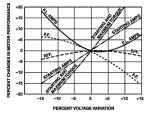You can generalize that the motor current will increase by the same ratio of the voltage differential, so 10% is a good rule of thumb. But success really does depend on the application.
A motor only draws the amount of current that the load demands of it, and that demand is in the form of torque. A motor produces steady state running torque that is the basis of the HP rating given to it, called Full Load Torque or FLT. But it also produces short bursts of Locked Rotor Torque (LRT) when first energized and Break Down Torque (BDT) at its maximum rated slip before it begins to stall. LRT and BDT are used in many machines to initially accelerate the load or to re-accelerate it quickly after a step change in load. At a reduced voltage, the motor FTL drops at the same rate as the voltage drop, so 208/230 = .904, SO at a 10% V drop the motor produces 10% less torque. However if the LOAD still requires the same amount of torque, the motor must increase its torque, so slip increases and the motor draws 10% more current. But as voltage drops, the LRT and BDT drops at the SQUARE of the voltage change. A 10% drop in V then results in the LRT and BDT dropping to only 81% of rated. That means the motor will take longer to accelerate from a standstill and it will take longer to recover from a change in load. If the load or change in load has a lot of inertia, the motor may not be able to handle it and stall.
So if the load is something like a centrifugal pump or fan, you will likely never need LRT or BDT and just experience the 10% increase in current at a given load. But if the machine is a heavy load, like a conveyor or a reciprocal compressor, or has a lot of inertia like anything with a flywheel effect, the bigger problem may be an increases likelihood of stalling or overloading as it tries to respond.

